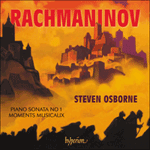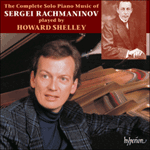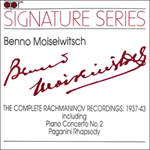
Welcome to Hyperion Records, a British classical label devoted to presenting high-quality recordings of music of all styles and from all periods from the twelfth century to the twenty-first.
Hyperion offers both CDs, and downloads in a number of formats. The site is also available in several languages.
Please use the dropdown buttons to set your preferred options, or use the checkbox to accept the defaults.

| Steven Osborne (piano)» More |
Chopin is the most obvious influence here, with the Nocturnes close to the surface of Nos 1 and 5, and the Études in Nos 2, 4 and 6. But Rachmaninov’s pieces feel broader and more monumental, with a new virtuosity arising from thicker textures containing several melodic strands. In the first four pieces the mood is unremittingly dark—‘gloomy like the man himself’, as one contemporary put it.
The elegiac melody of No 1 floats over the nocturne-like accompaniment and passes through several variations without shedding its character. No 2 is more dynamic, its surging spirit taking inspiration from Schumann. No 3, perhaps the best known of the series, is also the most unusual. This profoundly mournful music is written with great economy of means, the melodic material always presented in parallel thirds that form bold and poignant sonorities in conjunction with the left-hand chords. The hints of a funeral march are confirmed in the middle section, which is underpinned by the symbol of death, the Dies irae motif. The piece also looks back to Bach’s sarabandes, and invokes the Baroque formal pattern by repeating the second half. Various commentators have noted that the melody and texture are reminiscent of Wagner’s ‘Im Treibhaus’ (‘In the greenhouse’) from the Wesendonck Lieder, a song of desolation whose material Wagner used again in Tristan and Isolde. Rachmaninov brews up a tempest in No 4, possibly inspired by Chopin’s famous ‘Revolutionary’ étude. Calm is restored by the barcarolle of No 5, which beautifully evokes the gentle swaying of the waves under the gondola. The set closes with the grand finale of No 6, majestic and heroic in character, which draws again from Chopin, looks ahead to the final number of Rachmaninov’s own Op 32 preludes, and even points towards the bold sweep of his piano-writing in the concertos.
from notes by Marina Frolova-Walker © 2022
Ici, Chopin est l’influence la plus évidente, avec les Nocturnes proches de la surface des nos 1 et 5, et les Études dans les nos 2, 4 et 6. Mais les pièces de Rachmaninov ont l’air plus larges et plus monumentales, avec une nouvelle virtuosité provenant de textures plus épaisses tissées avec plusieurs fils mélodiques. Dans les quatre premières pièces, l’atmosphère est sombre en permanence—«lugubre comme l’homme lui-même», selon l’un de ses contemporains.
La mélodie élégiaque du nº 1 flotte au dessus d’un accompagnement dans le style d’un nocturne et passe par plusieurs variations sans perdre son caractère. Le nº 2 est plus dynamique, son esprit déferlant évoquant Schumann. Le nº 3, peut-être le plus connu de la série, est aussi le plus insolite. Cette musique profondément mélancolique est écrite avec une grande économie de moyens; le matériel mélodique est toujours présenté en tierces parallèles qui forment des sonorités audacieuses et poignantes conjointement avec les accords de la main gauche. Les soupçons de marche funèbre sont confirmés dans la section centrale, qui est étayée par le symbole de la mort, le motif du Dies irae. Cette pièce revient aussi sur les sarabandes de Bach et évoque le modèle formel baroque en reprenant la seconde moitié. Certains analystes ont relevé que la mélodie et la texture font penser à «Im Treibhaus» («Dans la serre») des Wesendonck Lieder de Wagner, un lied de désolation dont Wagner réutilisa le matériel dans Tristan et Isolde. Rachmaninov prépare une tempête dans le nº 4, peut-être inspiré de la célèbre étude «Révolutionnaire» de Chopin. Le calme est rétabli par la barcarolle du nº 5, qui évoque admirablement le doux balancement des vagues sous la gondole. Le recueil s’achève avec le grandiose finale du nº 6, de caractère majestueux et héroïque, qui s’inspire encore de Chopin. Il annonce le dernier numéro des propres préludes, op.32 de Rachmaninov, et évoque même l’ampleur audacieuse de l’écriture pianistique de ses concertos.
extrait des notes rédigées par Marina Frolova-Walker © 2022
Français: Marie-Stella Pâris
Chopin ist dabei der offensichtlichste Lehrmeister—der Einfluss der Nocturnes wird in Nr. 1 und 5 und derjenige der Etüden in Nr. 2, 4 und 6 spürbar. Rachmaninows Stücke wirken jedoch ausgedehnter und monumentaler, wobei aus den dichteren Strukturen mit mehreren melodischen Strängen eine neue Virtuosität entsteht. In den ersten vier Stücken ist die Stimmung unablässig düster—„düster wie der Mann selbst“, wie es ein Zeitgenosse ausdrückte.
Die elegische Melodie von Nr. 1 schwebt über der nocturneartigen Begleitung und durchläuft mehrere Variationen, ohne dabei ihre Charakteristika zu verlieren. Nr. 2 ist dynamischer angelegt und erinnert in ihrem aufbrausenden Geist an Schumann. Nr. 3, das vielleicht bekannteste Stück dieser Sammlung, ist auch das ungewöhnlichste. Diese zutiefst schwermütige Musik ist mit äußerst sparsamen Mitteln komponiert; das melodische Material erklingt stets in Terzparallelen, die in Verbindung mit den Akkorden der linken Hand kühne und ergreifende Klänge bilden. Im Mittelteil bestätigt sich die Andeutung eines Trauermarsches, der mit dem Dies irae-Motiv, dem Todessymbol, unterlegt ist. Das Stück bezieht sich zudem auf Bachs Sarabanden und greift durch die Wiederholung der zweiten Hälfte auch die formale Struktur des Barock auf. Verschiedene Forscher haben festgestellt, dass sowohl Melodie als auch Struktur an die verzweifelte Nummer „Im Treibhaus“ aus Wagners Wesendonck-Liedern erinnern, deren Material Wagner später in Tristan und Isolde wiederverwendete. In Nr. 4 lässt Rachmaninow einen Sturm aufziehen, der möglicherweise von Chopins berühmter „Revolutionsetüde“ inspiriert ist. Die Ruhe kehrt mit der Barcarolle, Nr. 5, zurück, in der das sanfte Wiegen der Wellen unter der Gondel wunderschön nachgezeichnet wird. Die Sammlung schließt mit dem großen Finale von Nr. 6, eine majestätisch-heroische Nummer, die sich wiederum auf Chopin bezieht und zugleich das letzte von Rachmaninows Préludes op. 32 und sogar den kühnen Klavierstil seiner Solokonzerte vorwegnimmt.
aus dem Begleittext von Marina Frolova-Walker © 2022
Deutsch: Viola Scheffel
 Rachmaninov: Piano Sonata No 1 & Moments musicaux Rachmaninov: Piano Sonata No 1 & Moments musicaux‘Rachmaninov fans won’t want to miss this’ was Gramophone’s verdict on Steven Osborne’s Études-tableaux, and this thrilling release is an equally essential acquisition. Osborne proves a predictably fine exponent of the Faustian Piano Sonata No 1, ...» More |
 Rachmaninov: The Complete Solo Piano Music Rachmaninov: The Complete Solo Piano Music‘A fine achievement from Howard Shelley and Hyperion alike. These superbly recorded, idiomatic readings demonstrate Shelley's virtuoso pianism and aff ... ‘A significant testimony to Howard Shelley's artistry. Pianistically impeccable, he understands what Rachmaninov was about’ (Gramophone)» More |
 Benno Moiseiwitsch - The complete Rachmaninov recordings, 1937-43 Benno Moiseiwitsch - The complete Rachmaninov recordings, 1937-43This is a recording from Appian Publications & Recordings Ltd (to quote the full title)—the label invariably more familiarly known simply as "APR". Since its foundation in 1986, APR has won an enviable reputation as a quality label devoted ...» More |
 Manía ManíaAn album of personal favourites, ranging from Ginastera and Albéniz, Bach and Chopin, to Prokofiev and Rachmaninov, and even a Strauss song transcription: the whole, music of a profound tranquillity.» More |

